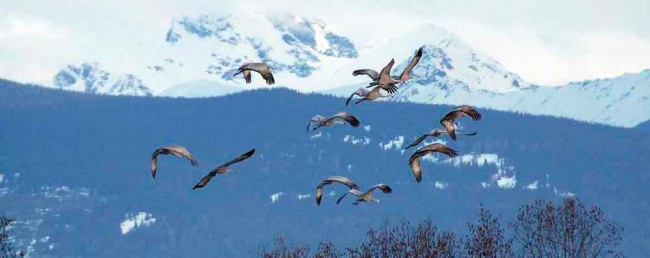
Photo Credit: Emily Bulmer
Singing, Winging Signs of Spring: How casual bird watchers are contributing to scientific knowledge
As the snow melts and reveals muddy pathways, neglected dog deposits and last fall’s unfinished yard work, many people just want to get the heck out of town.
But while some folks buy tickets to Mexico to escape the brown season for a few weeks, there are tropical travellers making their way north. Every year birds migrate from the southern US, Mexico and Central America to breed in northern BC and beyond in the Arctic. As pussy willows pop and crocuses reach for the sky, giving hope of warmer weather to come, the migration cycle marks the true arrival of spring. Bird biologist Kerrith McKay spends each spring witnessing the flurry of arrivals.
“It starts in April with the waterfowl,” she says. Geese, ducks, swans and cranes pass through northern BC. While some make their summer homes here, many are on their way to breeding grounds in the Arctic. It seems a long way to go to have babies, but the payoff is worthwhile: a feast of insects as they hatch all across the tundra. Birds rely on this constant food source to feed their young until they are ready to fly south.
“The cranes arrive in April and going out to see them is kind of like a rite of spring,” McKay remarks. Sandhill crane migration is a spectacular sight, with noisy funnel clouds of birds landing in flooded fields and valley bottoms. Travelling from New Mexico and Texas all the way to the Arctic, sandhill cranes can fly more than 500 km per day at an elevation of up to 3,600 m.
“Overwintering habitat and summer breeding habitat are really important, but it is the stopover habitat that can be the most limiting for migrants,” McKay says. Fields, marshes, forests and greenways are critical for rest and refuelling as the birds make their long and perilous journeys north. “There are many species you can see that are just passing through—sandpipers, yellowlegs and flocks of white-throated sparrows. They may not be breeding here, but you will see them.”
Birds do it, bees do it
As spring progresses, songbirds start to arrive in northern BC to breed.
“May and June is the the most fun time to watch birds. Starting in May, you can observe a new species every few days right into June,” McKay says. When they arrive, they are singing to find mates and defend territory, giving away their location, and because the leaves aren’t out, they are very easy to see.
“If you are trying to learn new birds, it is the best time. It’s not daunting because everything comes in gradually. If you can hear a bird three or four times and get a visual on it, you might remember it. It can be hard to go out in the summer and hear all the birds at once, especially when it is harder to see them.”
By walking through a wide range of habitat, including shoreline, open fields, aspen forest and mixed forest at both low and higher elevations, you increase your chances of seeing a wide range of birds.
“I really like the western tanager,” McKay says. “They are really beautiful with red and yellow plumage and as close to a tropical-looking bird that we will get. They can be found high up in the aspens.”
However, it isn’t always possible to see everything you believe is there. Some shy species such as the sora, which you’ll find in the wetlands, or the hermit thrush, found in the forest, will only make themselves known by their call. Red-winged blackbirds are always easy to see and hear near any body of water with their konk-kor-ee-ah call and the males’ trademark red and yellow markings.
The warblers, with their patches of bright yellow plumage, are not necessarily easy to spot, but the yellow flash of feathers and quick movement can draw an observer’s attention from afar. Some of the warblers that breed in northern BC include Wilson’s, Townsend’s, the yellow-rumped and the Canada warbler. Beyond identification, watching what the birds are doing for a few minutes opens up a new world.
“From when they arrive until the middle of July, they are in a state—staking out territory, finding a mate and raising their young,” McKay says. Whether you catch two males in a sing-off for territory or a mate or watch a pair build an intricate nest, there is a lot going on if you take the time to observe it.
Amateur observations
Watching birds isn’t only about what you see and hear; it is also about what is absent. Some Bulkley Valley birdwatchers have noticed a marked decline in the red-breasted nuthatch.
“They are not as ubiquitous as they once were,” McKay says. “They are easy to identify, especially with their ank ank call, but I looked back on some point counts (observations) and their numbers are definitely down over the last few years. We know that songbirds in general are in decline … and long-term bird studies help us understand these changes.”
She explains that long-term studies are rare and, as government priorities change, there often isn’t funding. There is hope, however, as citizen science increasingly supports bird research. One example of this is Bird Studies Canada’s Breeding Bird Atlases. Volunteers make observations on breeding birds and they are put in the public record. As scientists can’t collect all the data, “using everyone’s observations over the long term makes a lot of sense,” McKay says.
Anyone wishing to participate in the Bird Studies Canada programs can visit www.birdscanada.org for more information. A bird book, binoculars and a notebook and pencil are all you need.
Bird studies and volunteer observations are especially important with the growing impact of climate change. Bird migration is timed with photoperiod, or how many hours the sun shines in a day, and not temperature. Insects, however, hatch according to temperature. If breeding ground temperatures warm up before the birds arrive, breeding is out of synch with the food source. An early hatch can also turn the predator-prey relationship on its head; insects can prey on chicks before they have grown any feathers to protect them, which has been observed in the case of the peregrine falcon in the Arctic. When observations like this are passed along to organizations tracking the information, it helps answer questions when patterns change or populations decline.
Whether you are a seasoned birder checking off a “life list,” an appreciative bystander or a citizen scientist, watching spring bird activity is an opportunity to tune in to the world around us. Going for a walk and paying attention to the birds can be exciting and relaxing at the same time. Spring bird migration brings the fields, forests and skies to life and gives us earth-bound humans a chance to stand in awe of their heavenly accomplishments.




